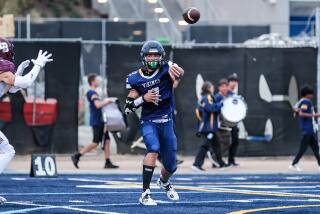AIR OF AZTEC WAYS : SDSU Targets Progress in Passing Game : College football: Luginbill hopes a healthy Lowery and more experience for receivers add up to an offense that relies less heavily on Faulk.
- Share via
SAN DIEGO — As the primary recruiter of Marshall Faulk, San Diego State receivers’ coach Curtis Johnson is getting more national publicity than ever.
When ABC television ran a halftime segment on Faulk a couple of weeks ago, they also interviewed Johnson. Like Faulk, Johnson has been on ESPN and in Sports Illustrated.
One problem.
Johnson’s publicity is certainly not resulting from the one area in which he would like--a prolific passing game.
Instead, partly because of Faulk and certainly for several other reasons, SDSU’s passing game has been more quiet this season than in any other in recent memory.
The Aztecs are averaging only 146.7 yards passing per game. To find the last time SDSU averaged fewer than 200 yards throwing per game, you have to go back 12 seasons, to 1980, when the Aztecs averaged 169 yards an outing.
The national exposure is fine with Johnson--so long as the Aztec passing game eventually kicks into gear. And he let his receivers know that one afternoon earlier this week as he led them into a meeting room.
“I’m getting a lot of pub,” he acknowledged in a loud, sarcastic voice, smiling, with his head turned toward the receivers. “But if my receivers don’t start catching the ball, they’re going to get me fired.”
In only three games, according to Johnson’s count, sophomore Darnay Scott has dropped five passes, junior Keith Williams has three drops, freshman H-back Ray Peterson has two and sophomore Curtis Shearer has one.
And these numbers don’t include the tight ends or running backs, who also have at least a couple apiece.
Coach Al Luginbill has noticed.
“I am concerned about it,” Luginbill said. “I’ve been concerned about it all year. We’re out of sync.
“We threw the ball decently against USC in the second half and at BYU we threw the ball well on first down. But, we’ve been able to run.
“What I don’t want to become at San Diego State is one-dimensional either way. I am concerned about it. We are spending overtime on it.”
In part, the passing attack has been marooned by the team’s Heisman Trophy contender. With Faulk racking up yardage like an out-of-control pinball player, the Aztecs have not had to pass.
In three games, Faulk has 637 yards rushing and 44 more receiving. That is 61.8% of SDSU’s total 1,101 offensive yards.
“To be a successful offensive team, even if it means not having the ball in Marshall’s hands as much, we need to be balanced,” Luginbill said. “And we’ll work toward that end.
“Our thought process going into (Saturday’s) New Mexico game is that we need to throw the ball and we need to throw it effectively.”
The Aztecs are averaging 30 pass attempts a game. Last season, they averaged 36 attempts per game. At this same point last season--after three games--they also averaged 36 attempts per game.
Lowery has completed only 43.9% of his passes--36 of 82. Last season, Lowery hit on 56.6% of them--176 of 311.
Luginbill’s goal is to average 250 yards passing per game and 150 rushing--or, the other way around. Right now, the Aztecs are averaging 220 yards rushing a game and 146 passing.
“You’d like it to be 225 and 225,” Luginbill said. “But I think that’s being idealistic.”
In addition to Faulk’s success and dropped passes, there are at least three other reasons why the Aztec passing game has been grounded:
* Youth. Scott, a sophomore who will play in only his 16th college game on Saturday, is the graybeard of the receiving group. Williams, a junior, had never started a game before this season. Neither had Peterson, a freshman; Shearer, a sophomore; or DeAndre Maxwell, a freshman who is a backup H-back and flanker.
Jake Nyberg, a junior backup flanker who injured a hip and is out this week, has also played sparingly. This all contributes to drops. There is a direct correlation between wet-behind-the-ears and butterfingers.
“They’re starting to get in the right places (on pass routes), but they’ve got to make some catches,” Johnson said.
* Opponents. Unlike in past seasons, there was no early-season game against a Pacific or Cal State Long Beach to work out the kinks. USC, BYU and UCLA are imposing enough at the end of the season, let alone early.
“We played three top-25 teams,” Johnson said. “In each case, they ran something different in the back end. In the games, (SDSU receivers) have got to remember what we did in practice and what they saw on the films.”
And younger, inexperienced players have a more difficult time remembering.
* Snaps. After quarterback David Lowery missed a week of practice with a strained lower back and center Mike Alexander suffered an ankle sprain in the first quarter at UCLA, the Aztecs couldn’t even snap the ball right against the Bruins. They fumbled two snaps and Lowery found himself waiting a split second longer under the center on most others.
The Aztecs passed for only 142 yards against UCLA. And Scott, Lowery’s favorite target, caught only one pass for 45 yards.
“David’s back was hurting really bad,” Scott said. “He got knocked down a couple of times and got back up with a frown on his face.
“It got to the point where I was just blocking because David was looking at me like, ‘It hurts.’ ”
The Aztecs say that the passing game will click any day now. Johnson thinks the receivers are starting to run the correct routes more often than not. Lowery thinks his back will be much better in time for New Mexico. And the Lobos certainly are not in the same class with UCLA and USC.
“Three factors all have to be done at the same time in completing a pass,” Luginbill said. “The receivers and quarterback have to be on the same page and protection is involved. Right now, we may have one or two, but not all three consistently.”
The Aztec coaches have trimmed the passing portion of their playbook a bit this week. It is Luginbill’s philosophy that you narrow down what you are doing in order to become better at it.
However, even if they narrow all the way down to one passing play, there is still one element you cannot overlook in a completed pass: Catching the ball.
“We’re coming on strong,” Scott said. “We miss a couple of passes a game, but it’s going to be at the point where we don’t miss (any) passes.”
If what Luginbill says about not putting the ball in Faulk’s hands as much in order to balance the offense is true, the receivers had better reach that point soon.
Either that, or put in some orders for Super Glue.
More to Read
Go beyond the scoreboard
Get the latest on L.A.'s teams in the daily Sports Report newsletter.
You may occasionally receive promotional content from the Los Angeles Times.










